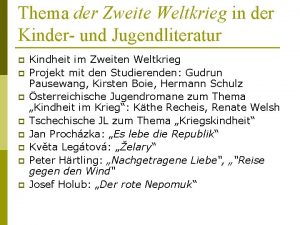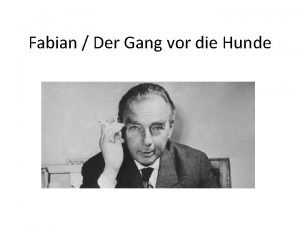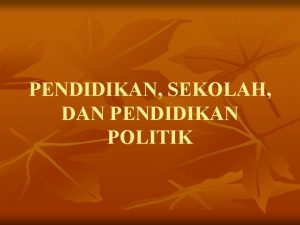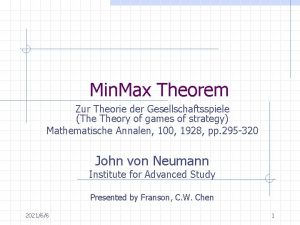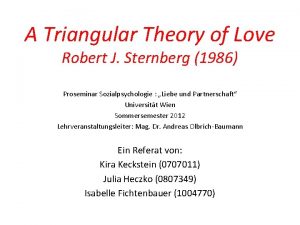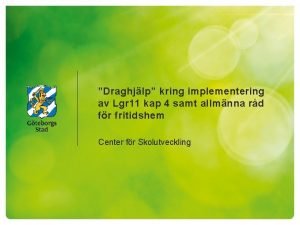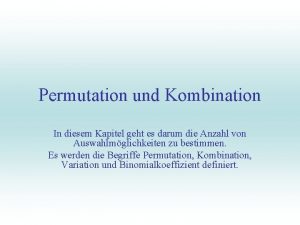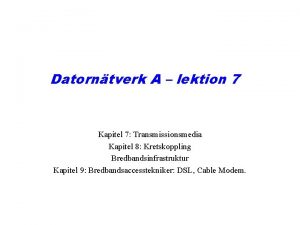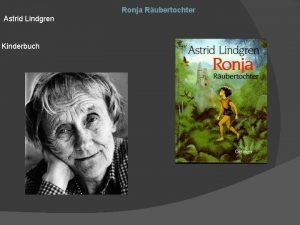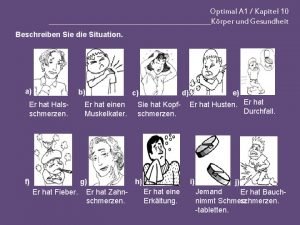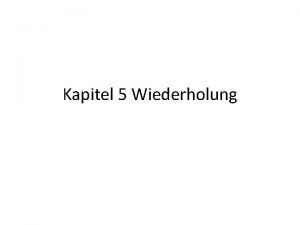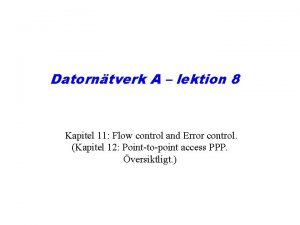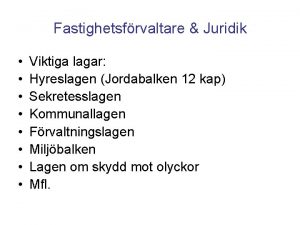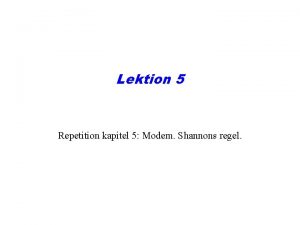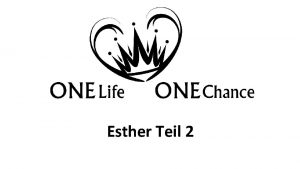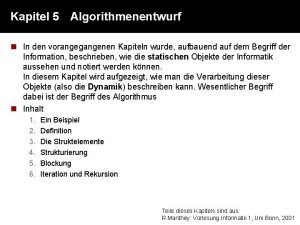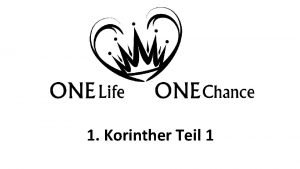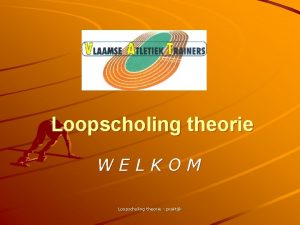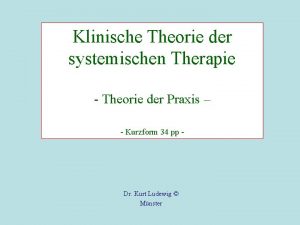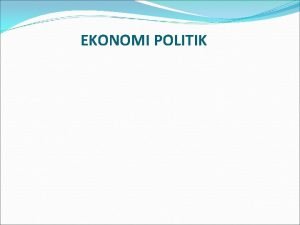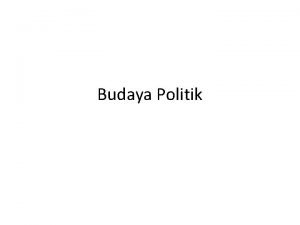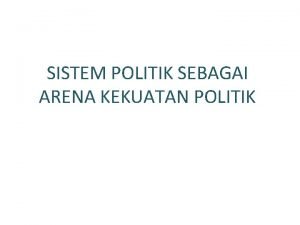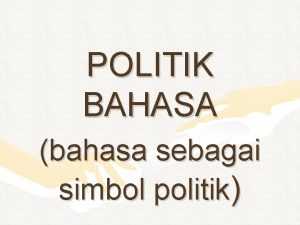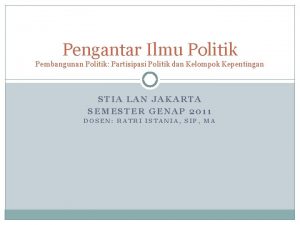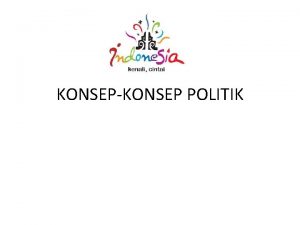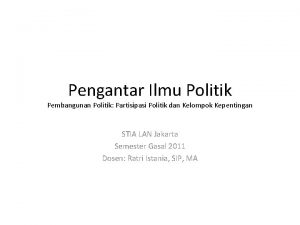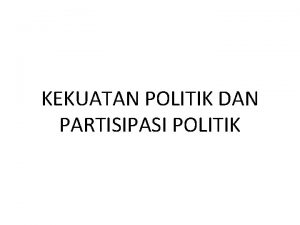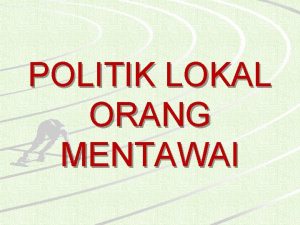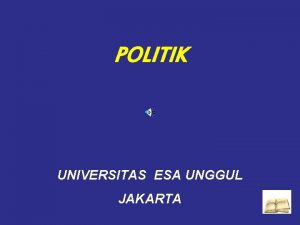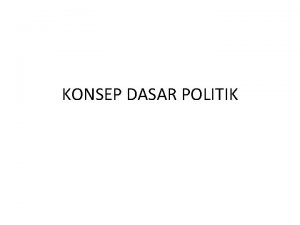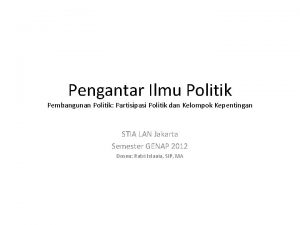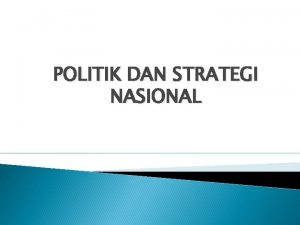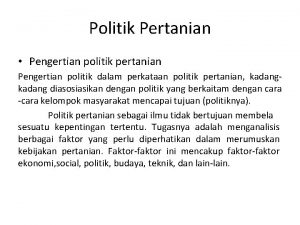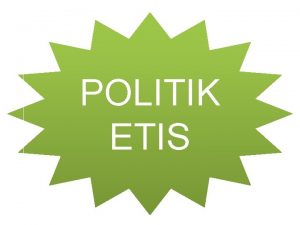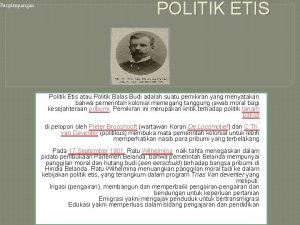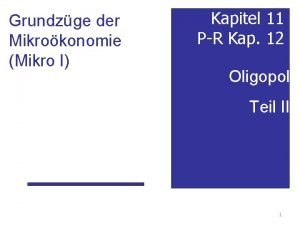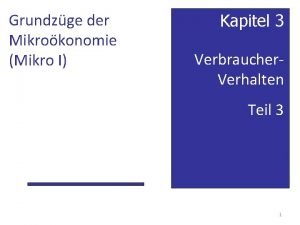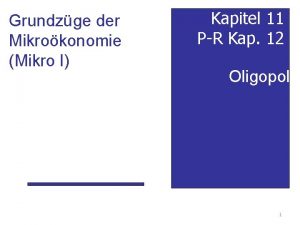Kapitel 4 Grundzge der konomischen Theorie der Politik


























- Slides: 26

Kapitel 4 Grundzüge der ökonomischen Theorie der Politik (VL Theorie der WIPO WS 16/17 Prof. Dr. Thomas Wein)

4. 1 Das Problem • Ziel: Anwendung neoklassischer Mikroökonomik auf politischen Prozess • Mikroökonomik zeigt, dass es in Märkten zu Pareto-Effizienz kommt • NPÖ/Public Choice fragt, ob Anreize im politischen Prozess zu gleichen = effizienten Ergebnissen führen • Politischer Prozess als politischer Markt • Neben Markt- gibt es auch Staatsversagen 2 Prof. Dr. Thomas Wein, WIPO Kapitel 4 "Ökonomische Theorie der Politik"

4. 2 Voters 4. 2. 1 Voting Paradoxon —Rational voters will not vote —Downs (1957): Net expected utility? Anthony Downs, * 1930 —In case of national elections: Own vote probably has no influence on election VL WIPO, Prof. Dr. Thomas Wein WS 16/17 3

4. 2 Voters 4. 2. 1 Voting Paradoxon —Rational voters will not vote —Participation in elections – civic duty? —Participation as an expressiv action? VL WIPO, Prof. Dr. Thomas Wein WS 16/17 4

4. 2. 2 Inconsistent Collective Decisions Individuals elect according their own objectives Arrows (1963) has shown that collective order may exist: - collective rational (transitivity) - weak Pareto-priniple - Independeny from non-relevant alternatives - Non-dictatorship - Non exclusion of preferences Kenneth Arrow, *1923 Nobel laureate 1972 => Arrow´s Impossibility Theorem VL WIPO, Prof. Dr. Thomas Wein 5

4. 2. 2 Inconsistent Collective Decisions Simple Majority Rule (50 % +1 Votes) Table 14. 2 Majority voting: cyclical (Cullis/Jones 2009, S. 491) VL WIPO, Prof. Dr. Thomas Wein 6

4. 2. 2 Inconsistent Collective Decisions Simple Majority Rule (50 % +1 Votes) Table 14. 3 Outcome dependency on agenda setting (Cullis/Jones 2009, S. 491) Intransitivity might be relevant, but must not be; Outcome depends on voting sequences VL WIPO, Prof. Dr. Thomas Wein 7

4. 2. 2 Inconsistent Collective Decisions Non-cyclical preference Table 14. 4 Majority voting: non-cyclical (Cullis/Jones 2009, S. 492) VL WIPO, Prof. Dr. Thomas Wein 8

4. 2. 2 Inconsistent Collective Decisions Figure 14. 2 Preferences and outcomes (Cullis/Jones 2009, S. 493) VL WIPO, Prof. Dr. Thomas Wein 9

4. 3 Politicians 4. 3. 1 Median Voter decides Number of Voters Left VL WIPO, Prof. Dr. Thomas Wein Right WS 16/17 10

4. 3 Politicians 4. 3. 2 Logrolling — Welfare Maximizing VL WIPO, Prof. Dr. Thomas Wein WS 16/17 11

4. 3 Politicians 4. 3. 2 Logrolling — Welfare Reduzing Voter Project Melanie Rhett Scarlet Hospital 200 -110 -105 Total Net Benefits -15 Library -40 150 -120 -10 Pool -270 -140 400 -10 VL WIPO, Prof. Dr. Thomas Wein WS 16/17 12

4. 3 Politicians 4. 3. 2 Logrolling — Welfare Maximizing VL WIPO, Prof. Dr. Thomas Wein WS 16/17 13

4. 4 Interest Groups 4. 4. 1 Group Interest as a Collective Good Mancur Olson 1965 (1932 -1998) Table 14. 5 Contribution to lobbying: the large number situation VL WIPO, Prof. Dr. Thomas Wein WS 16/17 14

2. 3. 4 Interest Groups 2. 3. 4. 1 Group Interest as a Collective Good Table 14. 5 Contribution to lobbying: the large number situation (Cullis/Jones 2009, S. 495) VL WIPO, Prof. Dr. Thomas Wein WS 16/17 15

2. 3. 4 Interest Groups 2. 3. 4. 2 Rent Seeking Robert D. Tollison *1942, 1998 + Gordon Tullock Figure 14. 3 The social costs of monopoly (Cullis/Jones 2009, S. 496 VL WIPO, Prof. Dr. Thomas Wein WS 16/17 16

4. 4 Interest Groups 4. 4. 2 Rent Seeking VL WIPO, Prof. Dr. Thomas Wein WS 16/17 17

4. 4 Interest Groups 4. 4. 2 Rent Seeking Figure 14. 4 Rent-Seeking: Producers versus Consumers (Cullis/Jones 2009, S. 498) VL WIPO, Prof. Dr. Thomas Wein WS 16/17 18

4. 4 Interest Groups 4. 4. 2 Rent Seeking Table 14. 7 Estimates of rent-seeking costs (Cullis/Jones 2009, S. 502) VL WIPO, Prof. Dr. Thomas Wein WS 16/17 19

4. 4 Interest Groups 4. 4. 3 Regulation as an Instrument of Vote Maximizing George Stigler 1911 -1991 Nobel Laureate 1982 Figure 14. 7 Stigler’s analysis of regulation (Cullis/Jones 2009, S. 503) VL WIPO, Prof. Dr. Thomas Wein WS 16/17 20

4. 4 Interest Groups 4. 4. 3 Regulation as an Instrument of Vote Maximizing Samuel Pelzman *1940, 1976 VL WIPO, Prof. Dr. Thomas Wein WS 16/17 21

4. 4 Interest Groups 4. 4. 3 Regulation as an Instrument of Vote Maximizing Figure 14. 8 Regulation to vote-maximis (Cullis/Jones 2009, S. 505) VL WIPO, Prof. Dr. Thomas Wein WS 16/17 22

4. 4 Interest Groups 4. 4. 5 Regulierung als Wettbewerb zweier Interessengruppen Gary S. Becker (1930 -2014, 2008) Nobelpreis 1992 VL WIPO, Prof. Dr. Thomas Wein WS 16/17 23

4. 5 Bureaucrats Max Weber, 1864 -1920 VL WIPO, Prof. Dr. Thomas Wein WS 16/17 24

4. 5 Bureaucrats William A. Niskanen 1933 -2011 1971 Figure 14. 11 Bureaucratic waste (Cullis/Jones 2009, S. 511 VL WIPO, Prof. Dr. Thomas Wein WS 16/17 25

Literature. —Cullis, John /Jones, Philip (2009), Microeconomics - a journey through life's decisions Harlow et al. (Prentice Hall), chapter 13. —Erlei, M. /Leschke, M. / Sauerland, D (2007): Neue Institutionenökonomik, Stuttgart (Poeschel), S. 354 -357. —Gruber, J. (2004). Public finance and public policy. Macmillan. —Rosen, H. R. /Gayer, T. (2013). Public Finance. Mc. Graw-Hill Higher Education, S. 33 -45, 106 -118, 263 -274. —Nicholson, W. /Snyder, W. /Luke, P. /Wood, M. (2008), Intermediate Microeconomics, London (Cengage Learning), S. 349 -361. VL WIPO, Prof. Dr. Thomas Wein WS 16/17 26
 Lena - unser dorf und der krieg kapitel zusammenfassung
Lena - unser dorf und der krieg kapitel zusammenfassung Fabian oder der gang vor die hunde wien
Fabian oder der gang vor die hunde wien Perbedaan pendidikan politik dan indoktrinasi politik
Perbedaan pendidikan politik dan indoktrinasi politik Min max theorem
Min max theorem Ckredit
Ckredit Dreieckstheorie
Dreieckstheorie Lgr 11 kap 4
Lgr 11 kap 4 Perfekt 1 kapitel 4
Perfekt 1 kapitel 4 Hiob kapitel 42
Hiob kapitel 42 Fliegender stern kapitel 5
Fliegender stern kapitel 5 Qmhandbuch überlingen
Qmhandbuch überlingen Wie viele wörter sind das
Wie viele wörter sind das Kallocain karin boye
Kallocain karin boye The australian connection zusammenfassung kapitel 7
The australian connection zusammenfassung kapitel 7 Ronja räubertochter zusammenfassung kapitel 3
Ronja räubertochter zusammenfassung kapitel 3 Emil und die detektive kapitel 12 zusammenfassung
Emil und die detektive kapitel 12 zusammenfassung Kapitel
Kapitel Bitterschokolade buch kapitel zusammenfassung
Bitterschokolade buch kapitel zusammenfassung Good pizza great pizza kapitel 3
Good pizza great pizza kapitel 3 Markus kapitel 16
Markus kapitel 16 Control kapitel
Control kapitel Jordabalken kapitel 12
Jordabalken kapitel 12 Kapitel 5 lektion a answers
Kapitel 5 lektion a answers Markusevangelium kapitel 10
Markusevangelium kapitel 10 Im vorangegangenen kapitel
Im vorangegangenen kapitel Brief an die galater kapitel 6
Brief an die galater kapitel 6 Korinthisieren
Korinthisieren
